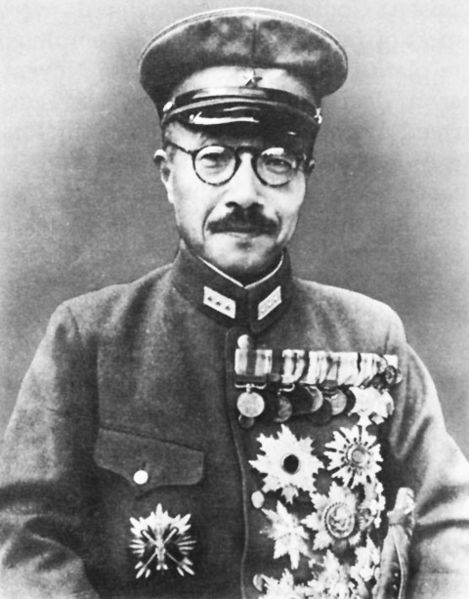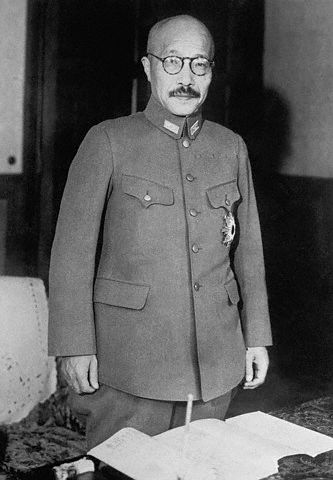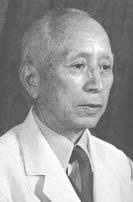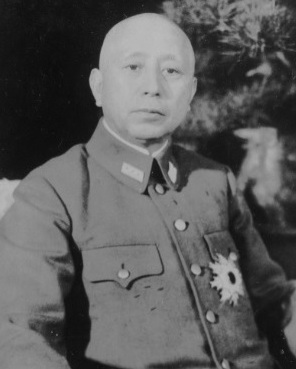<Back to Index>
- Prime Minister of Japan Hideki Tōjō, 1884
- General of the Imperial Japanese Army Yoshijirō Umezu, 1882
- Lieutenant General of the Imperial Japanese Army Seizo Ishikawa, 1897
PAGE SPONSOR


'Hideki Tōjō (Kyūjitai: 東條 英機; Shinjitai: 東条 英機) (30 December 1884 – 23 December 1948) was a general of the Imperial Japanese Army (IJA), the leader of the Taisei Yokusankai, and the 40th Prime Minister of Japan during most of World War II, from 17 October 1941 to 22 July 1944. As Prime Minister, he was directly responsible for the attack on Pearl Harbor, which led to the war between Japan and the United States, although planning for it had begun before he entered office. After the end of the war, Tōjō was arrested, sentenced to death for Japanese war crimes by the International Military Tribunal for the Far East, and was hanged on 23 December 1948.
Hideki Tōjō was born in the Kōjimachi district of Tokyo on 30 December 1884 as the third son of Hidenori Tōjō, a lieutenant general in the Imperial Japanese Army. He would later change his given name from the Chinese - inspired "Eiki" to the traditionally more Japanese "Hideki". In 1899, Tōjō entered the Army Cadet School. When he graduated from the Japanese Military Academy (ranked 10th of 363 cadets) in March 1905 he was commissioned as a second lieutenant in the infantry of the IJA. In 1909, he married Katsuko Ito, with whom he would have three sons and four daughters. By 1928, he had become the bureau chief of the Japanese Army, and was shortly thereafter promoted to colonel. He began to take an interest in militarist politics during his command of the 1st Infantry Regiment.
In 1933, Tōjō was promoted to major general and served as Chief of the Personnel Department within the Army Ministry. He was appointed commander of the IJA 24th Infantry Brigade in August 1934. In September 1935, Tōjō assumed top command of the Kempeitai of the Kwantung Army in Manchuria. Politically, he was fascist, nationalist and militarist, and was nicknamed "Razor" (カミソリ Kamisori), for his reputation for a sharp, legalistic mind capable of making quick decisions.
During the 26 February coup attempt of 1936, Tōjō and Shigeru Honjō, a noted supporter of Sadao Araki, both opposed the rebels. Emperor Hirohito himself was outraged at the attacks on his close advisers, and after a brief political crisis and stalling on the part of a sympathetic military, the rebels were forced to surrender. In the aftermath, the Tōseiha faction was able to purge the Army of radical officers, and the coup leaders were tried and executed. Following the purge, Tōseiha and Kōdōha elements were unified in their nationalist but highly anti - political stance under the banner of the Kōdōha military clique, with Tōjō in the leadership position. Tōjō was promoted to Chief of Staff of the Kwangtung Army in 1937. As Chief of Staff, Tōjō was responsible for the military operations designed to increase Japanese penetration into the Inner Mongolia border regions with Manchukuo. In July 1937, he personally led the units of the 1st Independent Mixed Brigade in Operation Chahar, his only real combat experience.
After the Marco Polo Bridge Incident marking the start of the Second Sino - Japanese War, Tōjō ordered his forces to attack Hopei and other targets in northern China. Tōjō received Jewish refugees in accordance with Japanese national policy and rejected the resulting Nazi German protests. Tōjō was recalled to Japan in May 1938 to serve as Vice Minister of War under Army Minister Seishirō Itagaki. From December 1938 to 1940, Tōjō was Inspector General of Army Aviation.
On 22 July 1940, Tōjō was appointed Army Minister in the second Fumimaro Konoe regime, and remained in that post in the third Konoe cabinet. He was a strong supporter of the Tripartite Pact between Japan, Nazi Germany and Fascist Italy. As the Army Minister, he continued to vastly expand the grueling war with China.
After negotiations with Vichy France, Japan was given permission to place its troops in French Indochina in July 1941. In spite of its formal recognition of the Vichy government, the United States retaliated against Japan by imposing economic sanctions in August and a total embargo on oil and gasoline exports.
On 6 September, a deadline of early October was fixed in the Imperial Conference for resolving the situation diplomatically. On 14 October, the deadline had passed with no progress. Prime Minister Konoe then held his last cabinet meeting, where Tōjō did most of the talking:
For the past six months, ever since April, the foreign minister has made painstaking efforts to adjust relations. Although I respect him for that, we remain deadlocked... The heart of the matter is the imposition on us of withdrawal from Indochina and China... If we yield to America's demands, it will destroy the fruits of the China incident. Manchukuo will be endangered and our control of Korea undermined.
The prevailing opinion within the Japanese Army at that time was that continued negotiations could be dangerous. However, Hirohito thought that he might be able to control extreme opinions in the army by using the charismatic and well connected Tōjō, who had expressed reservations regarding war with the West, although the Emperor himself was skeptical that Tōjō would be able to avoid conflict. On 13 October, he declared to Kōichi Kido, "There seems little hope in the present situation for the Japan - U.S. negotiations. This time, if hostilities erupt, I might have to issue a declaration of war."
On 16 October, Konoe, politically isolated and convinced that the Emperor no longer trusted him, resigned. Later, he justified himself to his chief cabinet secretary, Kenji Tomita:
Of course His Majesty is a pacifist, and there is no doubt he wished to avoid war. When I told him that to initiate war is a mistake, he agreed. But the next day, he would tell me: "You were worried about it yesterday, but you do not have to worry so much." Thus, gradually, he began to lead toward war. And the next time I met him, he leaned even more toward war. In short, I felt the Emperor was telling me: "My prime minister does not understand military matters, I know much more." In short, the Emperor had absorbed the views of the army and navy high commands.
At the time, Prince Naruhiko Higashikuni was said to be the only person who could control the Army and the Navy and was recommended by Konoe and Tōjō as Konoe's replacement. Hirohito rejected this option, arguing that a member of the imperial family should not have to eventually carry the responsibility for a war against the West. Following the advice of Kōichi Kido, he chose instead Tōjō, who was known for his devotion to the imperial institution.The Emperor summoned Tōjō to the Imperial Palace one day before Tōjō took office.
Tōjō wrote in his diary, "I thought I was summoned because the Emperor was angry at my opinion." He was given one order from the Emperor: To make a policy review of what had been sanctioned by the Imperial Conferences. Tōjō, who was on the side of the war, nevertheless accepted this order, and pledged to obey. According to Colonel Akiho Ishii, a member of the Army General Staff, the Prime Minister showed a true sense of loyalty to the emperor performing this duty. For example, when Ishii received from Hirohito a communication saying the Army should drop the idea of stationing troops in China to counter military operations of Western powers, he wrote a reply for the Prime Minister for his audience with the Emperor. Tōjō then replied to Ishii: "If the Emperor said it should be so, then that's it for me. One cannot recite arguments to the Emperor. You may keep your finely phrased memorandum."
On 2 November, Tōjō and Chiefs of Staff Hajime Sugiyama and Osami Nagano reported to Hirohito that the review had been in vain. The Emperor then gave his consent to war.
The next day, Fleet Admiral Osami Nagano explained in detail the Pearl Harbor attack to Hirohito. The eventual plan drawn up by Army and Navy Chiefs of Staff envisaged such a mauling of the Western powers that Japanese defense perimeter lines — operating on interior lines of communications and inflicting heavy Western casualties — could not be breached. In addition, the Japanese fleet which attacked Pearl Harbor was under orders from Admiral Isoroku Yamamoto to be prepared to return to Japan on a moment's notice, should negotiations succeed.
Two days later on 5 November, Hirohito approved the operations plan for a war against the West and continued to hold meetings with the military and Tōjō until the end of the month. On December 1, another conference finally sanctioned the "war against the United States, England and Holland".
Tōjō continued to hold the position of Army Minister during his term as Prime Minister, from 17 October 1941 to 22 July 1944. He also served concurrently as Home Minister from 1941 – 1942, Foreign Minister in September 1942, Education Minister in 1943 and Minister of Commerce and Industry in 1943.
As Education Minister, he continued militaristic and nationalist indoctrination in the national education system, and reaffirmed totalitarian policies in government. As Home Minister, he ordered various eugenics measures (including the sterilization of the "mentally unfit").
His popularity was sky high in the early years of the war, as Japanese forces went from one great victory to another. However, after the Battle of Midway, with the tide of war turning against Japan, Tōjō faced increasing opposition from within the government and military. To strengthen his position, in February 1944, Tōjō assumed the post of Chief of the Imperial Japanese Army General Staff. However, after the fall of Saipan, he was forced to resign on 18 July 1944.
After Japan's unconditional surrender in 1945, U.S. general Douglas MacArthur issued orders for the arrest of the first forty alleged war criminals, including Tōjō. Soon, Tōjō's home in Setagaya was besieged with newsmen and photographers. Inside, a doctor named Suzuki had marked Tōjō's chest with charcoal to indicate the location of his heart. When American military police surrounded the house on 8 September 1945, they heard a muffled shot from inside. Major Paul Kraus and a group of military police burst in, followed by George Jones, a reporter for The New York Times. Tōjō had shot himself in the chest with a pistol, but despite shooting directly through the mark, the bullets missed his heart and penetrated his stomach. Now disarmed and with blood gushing out of his chest, Tōjō began to talk, and two Japanese reporters recorded his words. "I am very sorry it is taking me so long to die," he murmured. "The Greater East Asia War was justified and righteous. I am very sorry for the nation and all the races of the Greater Asiatic powers. I wait for the righteous judgment of history. I wished to commit suicide but sometimes that fails."
He was arrested and underwent emergency surgery in a U.S. Army hospital. After recovering from his injuries, Tōjō was moved to Sugamo Prison. While there he received a new set of dentures made by an American dentist. Secretly the phrase "Remember Pearl Harbor" had been drilled into the teeth in Morse code.
He was tried by the International Military Tribunal for the Far East for war crimes and found guilty of the following:
- Count 1 (waging wars of aggression, and war or wars in violation of international law);
- Count 27 (waging unprovoked war against the Republic of China);
- Count 29 (waging aggressive war against the United States of America);
- Count 31 (waging aggressive war against the British Commonwealth of Nations);
- Count 32 (waging aggressive war against the Kingdom of the Netherlands);
- Count 33 (waging aggressive war against the French Republic);
- Count 54 (ordering, authorizing, and permitting inhumane treatment of Prisoners of War (POWs) and others).
It is natural that I should bear entire responsibility for the war in general, and, needless to say, I am prepared to do so. Consequently, now that the war has been lost, it is presumably necessary that I be judged so that the circumstances of the time can be clarified and the future peace of the world be assured. Therefore, with respect to my trial, it is my intention to speak frankly, according to my recollection, even though when the vanquished stands before the victor, who has over him the power of life and death, he may be apt to toady and flatter. I mean to pay considerable attention to this in my actions, and say to the end that what is true is true and what is false is false. To shade one's words in flattery to the point of untruthfulness would falsify the trial and do incalculable harm to the nation, and great care must be taken to avoid this.
He was sentenced to death on 12 November 1948 and executed by hanging on 23 December 1948. In his final statements, he apologized for the atrocities committed by the Japanese military and urged the American military to show compassion toward the Japanese people, who had suffered devastating air attacks and the two atomic bombings.
Many historians criticize the work done by General Douglas MacArthur and his staff to exonerate Emperor Hirohito and all members of the imperial family from criminal prosecutions. According to them, MacArthur and Brigadier General Bonner Fellers worked to protect the Emperor and shift ultimate responsibility to Tōjō.
According to the written report of Mizota Shūichi, interpreter for Admiral Mitsumasa Yonai, Fellers met the two men at his office on 6 March 1946 and told Yonai that "it would be most convenient if the Japanese side could prove to us that the Emperor is completely blameless. I think the forthcoming trials offer the best opportunity to do that. Tōjō, in particular, should be made to bear all responsibility at this trial."
The sustained intensity of this campaign to protect the Emperor was revealed when, in testifying before the tribunal on 31 December 1947, Tōjō momentarily strayed from the agreed upon line concerning imperial innocence and referred to the Emperor's ultimate authority. The American led prosecution immediately arranged that he be secretly coached to recant this testimony. Ryūkichi Tanaka, a former general who testified at the trial and had close connections with chief prosecutor Joseph B. Keenan, was used as an intermediary to persuade Tōjō to revise his testimony.
Tōjō's commemorating tomb is located in a shrine in Hazu, Aichi, and he is one of those enshrined at the controversial Yasukuni Shrine. His ashes are divided between Yasukuni Shrine and Zōshigaya Cemetery in Toshima ward, Tokyo.
He was survived by a number of his descendants, including his granddaughter, Yūko Tōjō, a right wing nationalist and political hopeful who claimed Japan's war was one of self defense and that it was unfair that her grandfather was judged a Class-A war criminal. Tōjō's second son, Teruo Tōjō, who designed fighter and passenger aircraft during and after the war, eventually served as an executive at Mitsubishi Heavy Industries.


Yoshijirō Umezu (梅津 美治郎 Umezu Yoshijirō) (4 January 1882 – 8 January 1949) was a general in the Imperial Japanese Army in World War II.
Umezu was born in Nakatsu (Ōita Prefecture). He graduated from the 15th class of the Imperial Japanese Army Academy in 1903 and served in the infantry. After graduation at the top of the 23rd class of the Army Staff College, he was sent to Europe for further studies in Germany and Denmark. While in Denmark, he was also a military observer from Japan during the course of World War I. From 1919 - 1921, he was appointed as a military attaché to Switzerland.
In 1920s, Umezu was a member of the Tōseiha led by General Kazushige Ugaki along with Gen Sugiyama, Koiso Kuniaki, Tetsuzan Nagata and Hideki Tōjō. They represented a politically moderate line between the armed forces, in opposition to the radical Kōdōha movement guided by Sadao Araki. He served as an instructor at the Army Staff College from 1923 – 1924, and was commander of the IJA 3rd Infantry Regiment from 1924 - 1926.
In the late 1920s and early 1930s, Umezu held a number of staff positions within the Imperial Japanese Army General Staff. He was promoted to major general in August 1930. Umezu returned to the field as a lieutenant general and commander of the Japanese China Garrison Army from 1934 – 1935 and as commander of the IJA 2nd Division from 1935 - 1936.
After being recalled to Japan in 1936, Umezu was appointed Vice Minister of War from 1936 - 1938. He returned to China in 1938 as commander - in - chief of the IJA 1st Army, and subsequently commander - in - chief of the Kwangtung Army from 1939 - 1944. He was promoted to full General in August 1939.
In July 1944, Umezu was appointed as the final Chief of the Imperial Japanese Army General Staff and a member of the Supreme War Council. Along with War Minister Korechika Anami and Soemu Toyoda, Chief of Imperial Japanese Navy General Staff, Umezu opposed surrender in August 1945; he believed that the military should fight on, forcing the Allies to sustain such heavy losses in an invasion of Japan, that Japan negotiate for peace under better terms. He was aware of the planned coup d'état by junior officers opposed to the surrender, but did nothing to either aid or hinder it. He was personally ordered by Emperor Hirohito to sign the instrument of surrender on behalf of the armed forces on 2 September 1945 and thus, was the Army's senior representative during the surrender ceremonies on the battleship USS Missouri at the end of World War II.
After the war, he was arrested by the SCAP authorities and tried as a war criminal at the International Military Tribunal for the Far East in Tokyo. He was found guilty of Counts 1, 27, 29, 31 and 32 of waging a war of aggression and sentenced to life imprisonment on 12 November 1948. While in prison, he became a convert to Christianity. Umezu died from rectal cancer in prison in 1949.
Seizo Ishikawa (Japanese: 清三石川, Seizō Ishikawa; Korean: 清三 이시카와, Qīngsam - Isikawa) (1897 - October 12, 1971) was a Japanese - Korean general who served in World War II.
Seizo Ishikawa was born in Seoul to a noble family in Korea, an empire that had been hostile to the nearby Empire of Japan. He grew in the climate of national pride and warfare, Korea overseeing the Sino - Japanese War and the Russo - Japanese War, the latter giving Korea to Japan in 1911. At the age of 15, in 1913, he joined the Japanese military academy in Osaka, where he served in the 23rd and 34th regiments of the Imperial Japanese Army. Three years later, he was made the governor of Korea by the Japanese occupants. In 1922, he aided in the Japanese invasion of China with 30,000 troops and 23 tanks, but the invasion was defeated due to the lack of supplies. But in 1930 he was in command of the large Japanese army in Manchukuo, which was going to take part in the oncoming invasion of China. In 1941, after commanding the northern invasion force during the Sino - Japanese War, he took part in the invasion of the Philippines by the Japanese. After the invasion of the Philippines, he was present at the Battle of Midway in 1942 and was stationed in the Philippines from February 1943. However, he was soon given control of the Makin Island garrison, and after it was seized by the Americans, he retired and moved to Hiroshima. He survived the cataclysm caused by the nuclear bomb in 1945, and soon became a business entrepreneur, making kitchen utensils along with his son. He died of cancer in 1971 after being one of Japan's richest men.